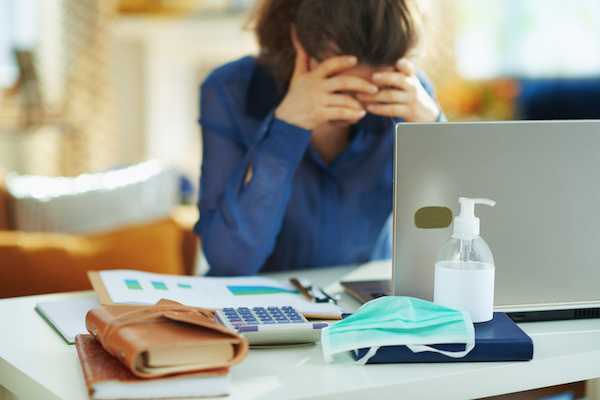Ever hear the term Blue Monday? It was coined several years ago by a psychologist in the United Kingdom who stated that the third Monday of January is the most depressing day of the year. Apparently, he made his claim about depression at the behest of a travel company that may have been trying to drum up some business during its slow season.
There is no scientific proof to back up his claim about depression and so … Blue Monday may not be a real thing, but the winter blues certainly are. The added stress of the pandemic has exacerbated many people’s struggle with seasonal depression, says therapist Lindy Graham.
Depression symptoms
The symptoms of winter blues and the more severe Seasonal Affective Disorder [SAD], which is also called depression with a seasonal pattern, usually occur during the fall and winter and improve with the arrival of spring. January and February tend to be the most difficult months for those experiencing depression related to seasonal changes. Many people continue to face the impact of COVID-19 on their mental health which makes this year more challenging for those with winter blues or SAD.
Lindy Graham, LCSW
In Maine, 35% of people suffer from winter blues, 15-19% from mild cases of SAD, and 9% from SAD. The exact cause of seasonal depression isn’t known, but it appears to be triggered by a lack of sunlight. “Not everybody in Maine gets seasonally depressed or has what we call seasonal affective disorder or SAD,” says now-retired University of Maine professor and researcher, Dr. Sandra Sigmon. “Some people are just that more sensitive to the amount of available sunlight and we really don’t know why that is.”
Common symptoms that may appear every fall and winter include:
- Sadness
- Anxiety
- Irritability
- Loss of interest in usual activities
- Inability to concentrate
- Extreme fatigue
- Lack of energy
- Need for more sleep
- Carbohydrate craving
- Weight gain
Depression at work
Whether there really is a Blue Monday phenomenon or not, the day is still an opportunity to learn more about depression and the impact it can have on all aspects of your life. That includes your work-life, says Lindy Graham. She is a licensed clinical social worker and founder of WellSpace Counseling Center in Portland and Yarmouth, Maine. WellSpace recently developed a program called WellSpace@Work which gives employers an opportunity to offer easy to access counseling to their employees and to pay for their sessions.
With all the stressors employees are facing today, offering a readily accessible, barrier-free path to counseling is a significant benefit that employers can consider.
Lindy Graham
Recent surveys
In a 2020 survey of approximately 1000 employers by McKinsey & Company, a global management consulting firm, “[Ninety] percent reported that the COVID-19 crisis was affecting the behavioral health and often the productivity of their workforce.”
Gallup’s annual Work and Education survey, conducted last summer, showed that employee’s job worries are at an all-time high.
- 27% of U.S. workers worry about being laid off, up from 15% in 2019
- 27% worry about having their work hours cut, up from 15% in 2019
- 28% worry that their wages will be reduced, up from 16% in 2019
- 30% worry that their benefits will be reduced, up from 23% in 2019
- Non-White workers are substantially more worried than White workers
Among those employers surveyed by McKinsey who said they were concerned about behavioral health issues, 70 percent said they had or will take action.
There’s a recognition that so much of the mental health challenges emerging now are the tip of the iceberg. We really can’t fully process trauma until we’re safe, and we’re still in the middle of all this. I think we’ll see a lot more distress emerge as things begin to settle down because people will be in a position to deal with it, and employees can be in a great position to make some requests around what their needs are. Even when employers don’t add an extra benefit like WellSpace@Work, there are great resources out there for improving wellness at work.
Lindy Graham
Treating depression
Dr. Sigmon, who continues to do research on a variety of behavioral and physical health issues, including seasonal changes, offers some suggestions of her own for coping with seasonal depression.
- Light therapy —10,000 lux — the amount of sunshine you’d be exposed to on a bright sunny day, helps a lot of people with seasonal depression.
- Some individuals may also need to take an antidepressant during the fall and winter months.
- Cognitive-behavioral therapy (Simply put, a cognitive-behavioral therapist helps people recognize how their thoughts affect their moods and behavior and works with them to replace negative patterns of thought with more positive or healthier patterns.)
- Get out in the natural sunlight as much as you can — at least 15 minutes a day to get the Vitamin D our bodies need. You can take a Vitamin D supplement, but being outside is especially beneficial because it also means you’re more likely to be active.
- If it’s a cloudy day, still go outside. Stroll around the block, walk the dog. At least you’ll be doing something.
- Inside, try to sit next to a window whenever possible.
- Keep up your normal activity level.
- Try to eat consistently across all seasons.
- Develop some hobbies or interests that you can do on long winter days — and during blizzards.
If you are interested in learning more about WellSpace@Work, visit the WellSpace website. I will also be writing more about the program in the near future.


Leave A Comment